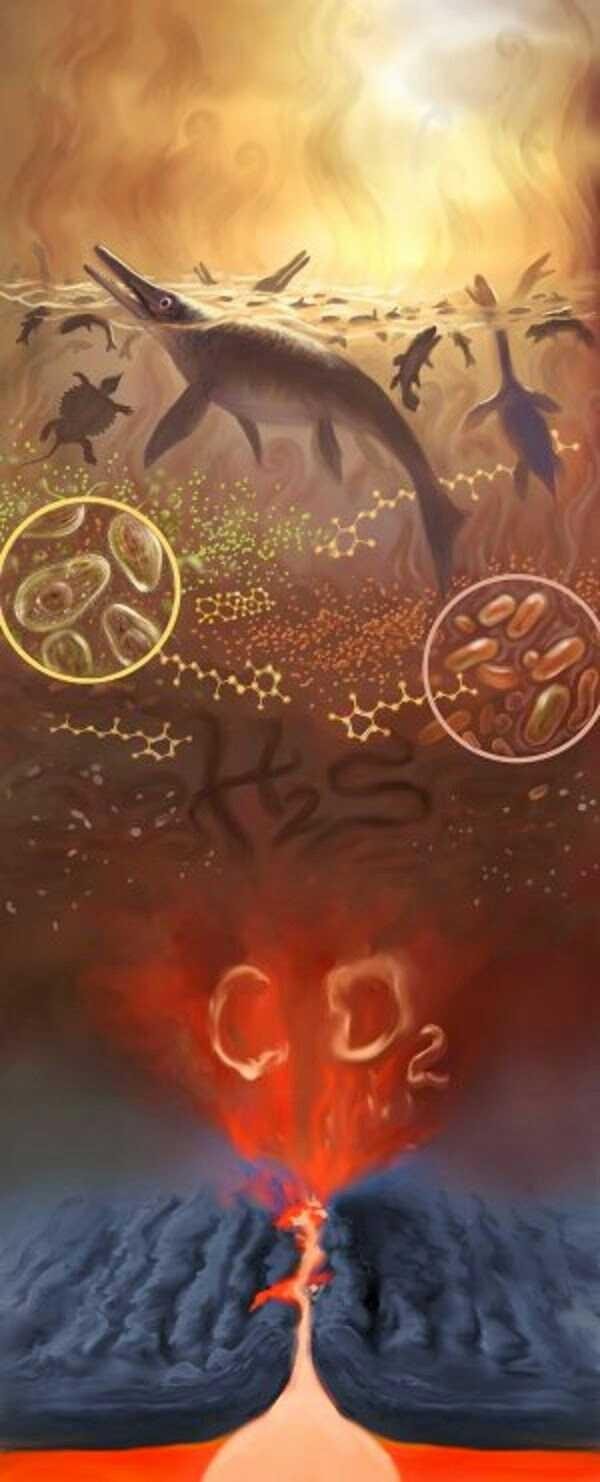Mass Extinction of Dinosaurs Caused by Sea Oxygen Disappears
The oxygen seas have an important role in mass extinctions more than 200 million years ago.
Nature has a major role in causing mass extinctions.
Far from the time when life took place more than 200 million years ago where scientists regarded the event as a result of the natural selection process and has a similar state to the current world as a result of continuous fossil burning.
The oxygen seas have an important role in mass extinctions more than 200 million years ago.
The change in marine biochemical balance is an important factor in the end of the Triassic mass extinction, in which half of all plants, animals and marine life on Earth are killed, according to new research involving the University of Southampton.
#The Natural Process of Mass Extinction of Dinosaurs
The study reveals that a condition called the 'euxinia photographic sea zone' takes place in the Panathalassic sea-the largest of the two oceans surrounding the Pangea supercontinent.
The international team of researchers studied fossils of organic molecules extracted from sedimentary rocks that initially accumulate in the lower north-eastern part of the Panthalassic Sea, but are now owned by the Queen Charlotte Islands off the coast of British Columbia, Canada.
The team found a molecule derived from photosynthetic brown pigmented green sulfur bacteria - microorganisms that exist only in very anoxic conditions - proving the lack of oxygen present and the contamination of hydrogen sulfide at sea level at the end of Triassic, 201 million years ago.
 
Previous studies have reported evidence of euxinia photovoltaic zones from terrestrial and shallow environments, near the coastal environment during the Triassic end period, but recent research aims to provide such evidence from open ocean settings, indicating possible changes on a global scale.
#Anoxia Event
An oceanic anoxic event or anoxic event (anoxic condition) occurs when the Earth's oceans become completely depleted of oxygen (O2) below the surface level.
Euxinic (Euxinia) refers to the condition of H2S anoxic hydrogen sulphide.
Although anoxic events do not occur for millions of years, geological records show that they happened many times in the past. Anoxic events may have caused mass extinctions.
This mass extinction includes some that geobiologists use as a marker of time in biostratigraphic dating.
It is believed an oceanic anoxic event is intimately linked in the key to today's oceanic circulation, climate warming and greenhouse gases. Increased volcanism (through the release of CO2) is a major external driver for euxinia.
The researchers also documented changes in the nitrogen composition of organic matter, suggesting that disturbances in the marine nutrient cycle coincide with the development of low oxygen conditions.
Assume that the earth releases large volumes of carbon dioxide during intense volcanic time intervals; global temperatures are increasing due to greenhouse effect; global weathering rates and increased fluvial fluid waves; increased organic productivity in the oceans; organic carbon burial in the ocean increases (OAE starts); carbon dioxide is withdrawn because both burials of organic matter and weathering silicate rocks (reverse greenhouse effect); global temperatures fall, and ocean-atmosphere systems return to equilibrium (OAE ends).
This change has the potential to disrupt the nutritional cycle and alter the food chain essential to the survival of marine ecosystems.
Anoxic conditions, and especially euxinic, greatly affect the food chain.
Although the Earth is very different during the Triassic Period compared to today, the rate of carbon dioxide release from the volcanic split is almost the same as what we are experiencing now through the burning of fossil fuels.
The consequences of the rapid rise in CO2 in ancient times could be a possible consequence of the current carbon dioxide crisis.
The only occurrence of documented marine anoxic from the Jurassic period lasted during the early Toarcian.
None of the drilling techniques of the DSDP (Deep Sea Drilling Project) or ODP (Ocean Drilling Program) are capable of obtaining black flakes from this period. Little or nothing left the crust of Toarsian left in the ocean in the world today.
An example of a black shale comes from outcrops on land. These outcrops, together with materials from some commercial oil wells, are found in all major continents and this seems to be similar in shape to two Cretaceous examples.
The occurrence of anoxic oceans can be seen as the earth's response to release the excess of carbon dioxide into the atmosphere and the hydrosphere.
One test of this idea is to look at the age of LIPs (large igneous provinces) - large hardened lava regions, extrusions that would probably have been accompanied by rapid effusion of large volcanogenic gases such as carbon dioxide.
Interestingly, the age of three LIPs (Karoo-Ferrar flood basalt, Carribean LIPs, Ontong Java Plateau) are highly correlated with Jurassic (early Toarcian) and Cretaceous (early Aptian and Senoman-Turonian) oceanic anoxic events, suggesting that causal relationships are easy happen.
Thanks information
World of Photography
>Visit the website<
Thank you for participating in #landscapephotography
You have earned 5.10 XP for sharing your photo!
Daily photos: 1/2
Daily comments: 0/5
Multiplier: 1.02
Server time: 07:53:18
Total XP: 22.20/100.00
Total Photos: 3
Total comments: 7
Total contest wins: 0
Follow: @photocontests
Join the Discord channel: click!
Play and win SBD: @fairlotto
Daily Steem Statistics: @dailysteemreport
Learn how to program Steem-Python applications: @steempytutorials
Developed and sponsored by: @juliank